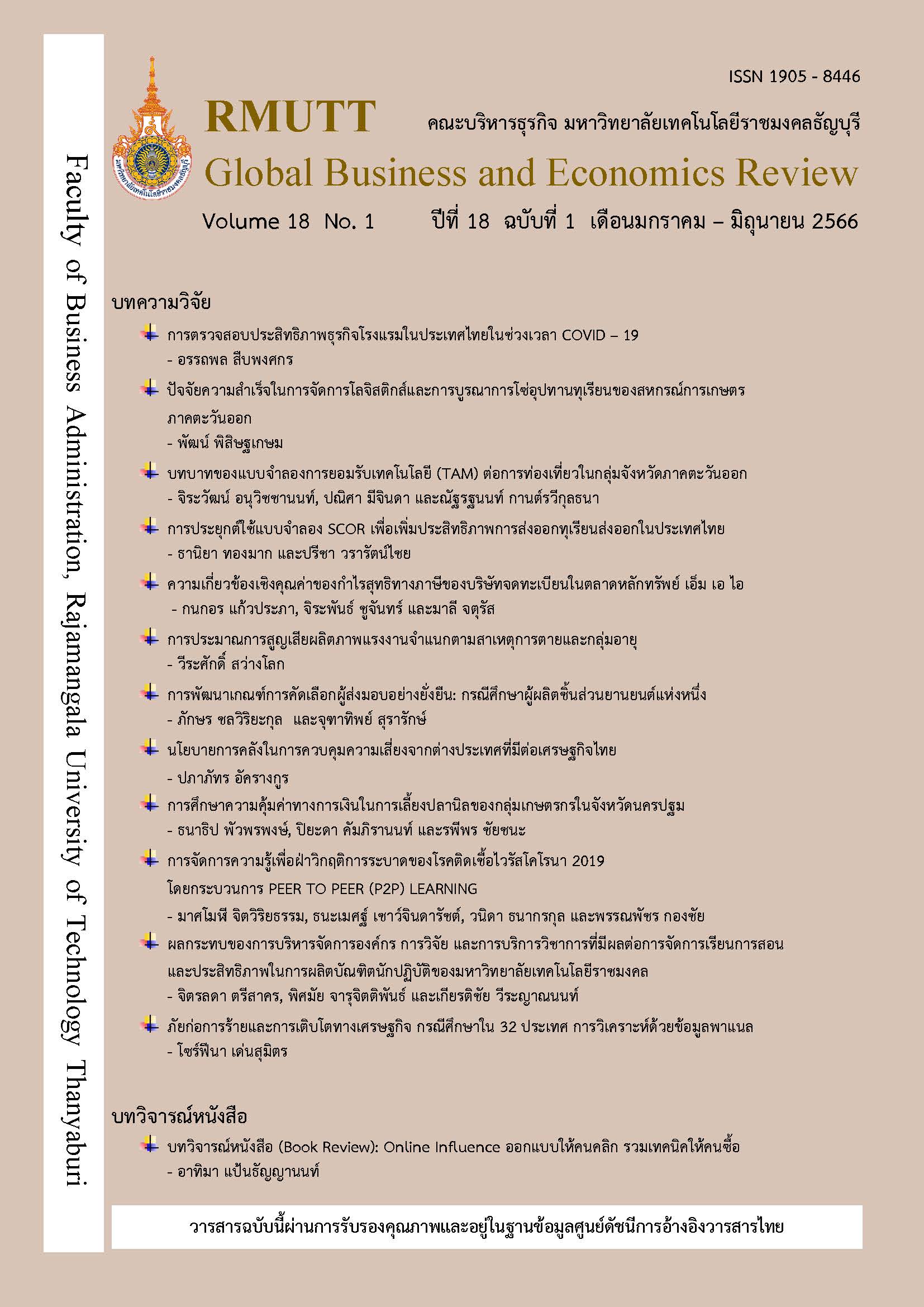THE APPLICATION OF SCOR MODEL TO INCREASE EXPORT PERFORMANCE OF DURIAN EXPORT IN THAILAND
Keywords:
Durian Export, Supply Chain Operations Reference, Export PerformanceAbstract
The application of the SCOR model to improve export efficiency in Thailand to develop and monitor the underlying cause of operation of the supply chain, competitiveness and external factors that influence export performance of Thai durian with a competitive advantage as a central variable. This research is volume research. The research is 400 entrepreneurs of durian export registered with Ministry of Commerce using 20 times criteria, specific variables, data collection, questionnaire data and data analysis. Acceptable levels of consistent model with index values 2 = 52.428, df = 57, p-value = 0.647,
2/df = 0.920, AGFI = .959, GFI = 0.985, CFI = 1.000, RMSEA = 0.000 and RMR = 0.005. The most effective influence on exports of durian in Thailand is that supply chain operations have a direct, positive, and even positive influence of 0.254 are external factors. Positive direct influence of 0.212 and competitive factors have significant positive, direct, positive, 0.212 influence on a level 0.05; external factors are also found to be external. There is a significant positive 0.216 indirect influence on a level 0.05 with supply chain operations and competitive advantage as a barrier to increasing export performance in Thailand. Therefore, increasing export efficiency will be important to supply chain operations and external factors. Development, improvement, and competitive advantage should be developed, especially by bringing technology innovation to a different level of cost, service, management, flexibility to manage the entire supply chain of exports to enhance the export performance of the country's durian.
References
กรมเจรจาการค้าระหว่างประเทศ. (2563). สินค้าทุเรียนและผลิตภัณฑ์. สืบค้นจาก https://api.dtn.go.th/files/v3/5e8d8de2ef414017d6406a9d/download
จันทร์ฉาย พิทักษ์อรรณพ. (2558). ผลสัมฤทธิ์ของการจัดการต่อการส่งออกของวิสาหกิจขนาดกลางและขนาดย่อมของไทย. วารสารการจัดการภาครัฐและภาคเอกชน, 22(1), 111-139.
พีรศักดิ์ ศักดิ์หงษ์ และ วิชญุตร์ งามสะอาด. (2564). การพัฒนาการบริหารห่วงโซ่อุปทานผลผลิตทุเรียนและการเพิ่มประสิทธิภาพกระบวนการคัดแยกทุเรียนด้วยหลักการ SCOR Model. Journal of Science and Technology, Southeast Bangkok College, 1(2), 25-38.
สำนักงานเศรษฐกิจการเกษตร กระทรวงเกษตรและสหกรณ์. (2565). สถิติการส่งออก (Export). สืบค้นจาก http://impexp.oae.go.th/service/export.php?S_YEAR=2560&E_YEAR=2564&PRODUCT_GROUP=5252&PRODUCT_ID=&wf_search=&WF_SEARCH=Y#export
สุกัญญา ศิรพิชญ์พิเชฏฐ. (2002). การเริ่มต้นธุรกิจการส่งออก. สืบค้นจาก https://www.ditp.go.th/contents_attach/78259/78259.pdf
Alimo, P. K. (2021). Reducing postharvest losses of fruits and vegetables through supply chain performance evaluation: an illustration of the application of SCOR model. International Journal of Logistics Systems and Management, 38(3), 384-407.
Barney, J. B. (1991). Firm resources and sustained competitive advantage. Journal of Management, 17(1): 99-120.
Bolstorff, P., & Rosenbaum, R. (2003). Supply chain excellence: A handbook of dramatic improvement using the SCOR model. New York: AMACOM.
Chelliah, S., & Lee, M. H. (2020). The moderating role of government support on food processing SME’s internal factors and the impact to export performance. International Journal of Asian Social Science, 10(12), 730-745.
Dubey, R., Gunasekaran, A., & Childe, S. J. (2018). Big data analytics capability in supply chain agility: The moderating effect of organizational flexibility. Management Decision. Retrieved from https://pearl.plymouth.ac.uk/bitstream/handle/10026.1/10854/ Rameshwar%20DUBEY%20BDA%20Mgt%20Decn%20Revised%20final%20version%20accepted.pdf?sequence=2
Escandon-Barbosa, D., Rialp-Criado, J., Fuerst, S., Rodriguez-Orejuela, A., & Castro-Aristizabal, G. (2019). Born global: the influence of international orientation on export performance. Heliyon, 5(11), 1-12.
Fernandes, A. C., Sampaio, P., Sameiro, M., & Truong, H. Q. (2017). Supply chain management and quality management integration: A conceptual model proposal. International Journal of quality & reliability management, 34(1), 53-67.
Hair, J. F., Anderson, R. E., Tatham, R. C., & Black, W. C. (1995). Multivariate data analysis, with readings. Englewood Cliffs, NJ. :Prentice Hall.
Hair, J. F., Black, W. C., Babin, B. J., & Anderson, R. E. (2010). Multivariate data analysis (7th ed.). New York: Pearson.
Healy, P., Serafeim, G., Srinivasan, S., & Yu, G. (2014). Market competition, earnings management, and persistence in accounting profitability around the world. Review of accounting studies, 19(4), 1281-1308.
Joo, S. H., & Shin, G. H. (2020). Empirical analysis of effect of entrepreneurship on export performance: focusing on the mediated effect of technology capability and export support policy of start-ups. Journal of Korea Trade, 24(6), 173-193.
Kolbe, D., Frasquet, M., & Calderon, H. (2021). The role of market orientation and innovation capability in export performance of small-and medium-sized enterprises: A Latin American perspective. Multinational Business Review, 30(2), 289-312.
Porter M. E. (1985). Competitive strategy: Techniques for analyzing industries and competitors. New York, NY: The Free Press.
Porter, M. E. (1990). The competitive advantage of nations. New York: Free Press.
Porter, M. E., & Miller, V. E. (1985). How information gives you competitive advantage. Harvard Business Review, 63(4), 149-60.
Supply Chain Council. (2012). Supply chain operations reference model. Retrieved from https://www.academia.edu/29275319/Supply_Chain_Operations_Reference_Model_Revision_11_0
Downloads
Published
How to Cite
Issue
Section
License
Copyright (c) 2023 ธานิยา ทองมาก, ปรีชา วรารัตน์ไชย

This work is licensed under a Creative Commons Attribution-NonCommercial-NoDerivatives 4.0 International License.
The articles published in this journal are the intellectual property of their respective authors.
The views and opinions expressed in each article are solely those of the individual authors and do not reflect the positions of Rajamangala University of Technology Thanyaburi or any of its faculty members. All components and content of each article are the sole responsibility of the respective authors. In the event of any errors, the authors shall bear full responsibility for their own work.








